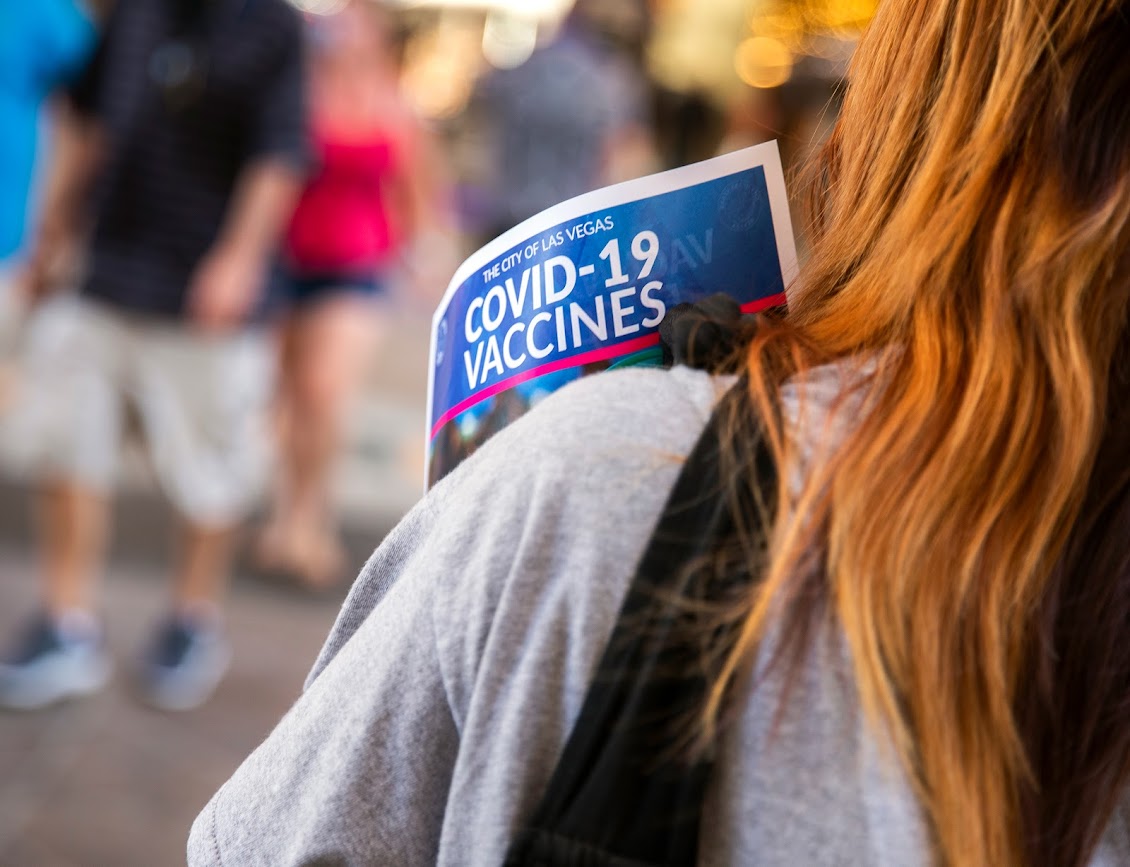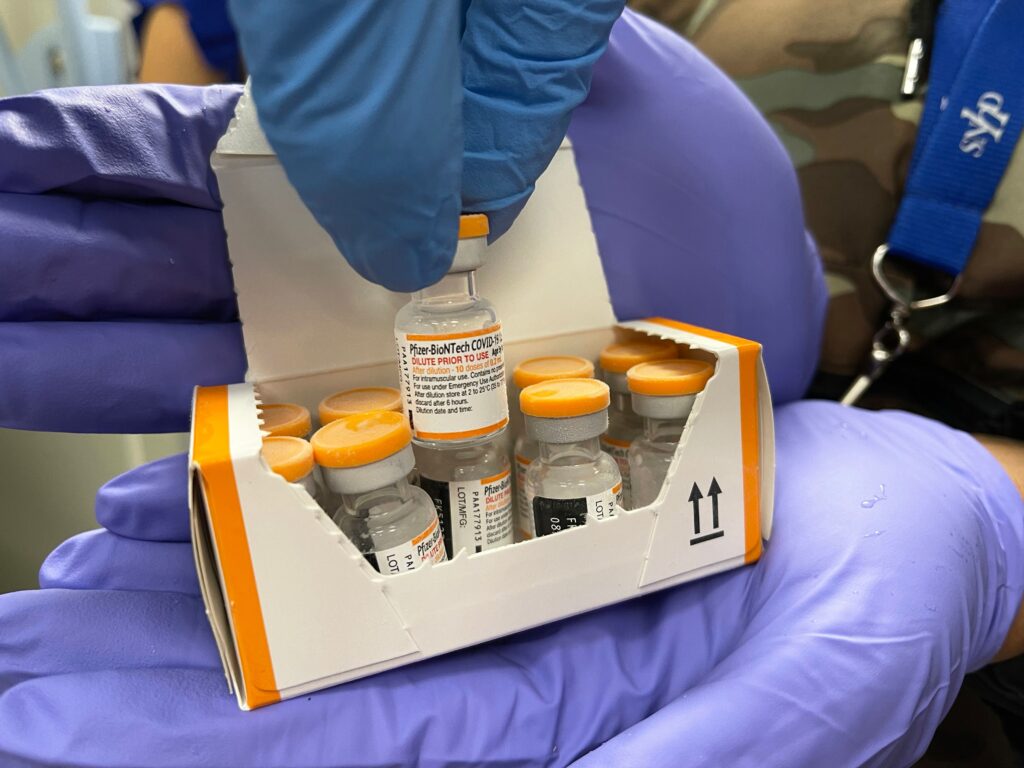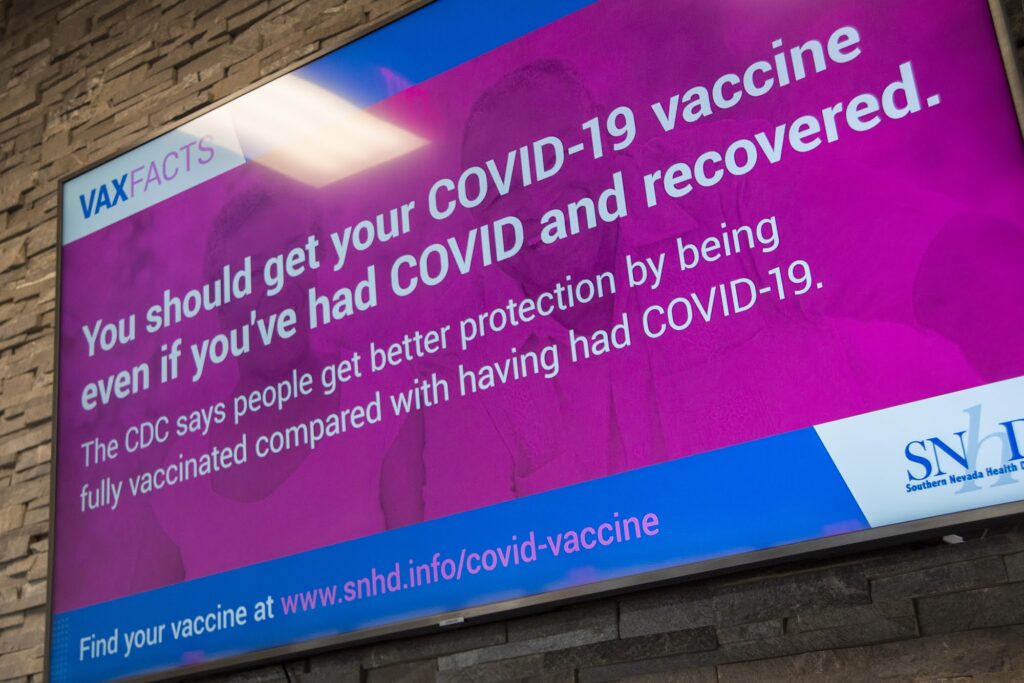COVID in Context: The end of free COVID vaccines? It might happen next year

Welcome to COVID in Context, where staff at The Nevada Independent provide context and clarity on what’s happening with COVID-19 in Nevada.
COVID in Context will change depending on the situation at hand. If you have any questions, thoughts or suggestions, please reach out to tabitha@thenvindy.com, send me a direct message on Twitter, or submit them using this form.
For updates, check out our data page.
Paying for COVID-19 vaccines
As federal funding for COVID-19 vaccines dwindles, putting the commercialization of those vaccines in closer sight, public health officials are bracing for access issues, especially among underinsured and uninsured populations.
To boost the country’s vaccination rate, U.S. Secretary of the Department of Health and Human Services Xavier Becerra said he and other officials are focusing on spreading information about existing free vaccines. He said the goal is to keep the vaccines readily available at no cost, but it all hinges on support from Congress.
President Joe Biden committed to making vaccines available for all Americans free of charge, Becerra told The Nevada Independent during an interview in early November. But he said that could change sometime next year unless Congress provides additional funding for the program.
“We’ve been engaged on a dual track. One, we’re making these vaccines available now, free of charge,” Becerra said. “At the same time, we’re working towards commercializing the vaccines so that they will be available but through the commercial market.”
When the vaccines become commercialized, the price per dose could be about $130 before insurance. Becerra said insurance companies are expected to pay for the vaccine, but the government will work to keep the vaccine affordable for those who may lack insurance.
“We will continue to make every effort to ensure that people have access to vaccines for whatever they can afford,” he said. “And for some folks that might not be any money and so we want people to be vaccinated because none of us are safe until all of us are safe.”
Though Becerra described seeing a “pandemic fatigue” among the general population, he said the triple threat of COVID, RSV and the flu has prompted more people to stay up to date on their vaccinations. Still, he said everyone must take steps to protect themselves so they can enjoy the holidays.
In mid-November, amid ongoing budget discussions, the White House requested more than $8 billion in additional funding for COVID-19 response efforts that would aid the development of COVID vaccines and treatments as the virus mutates. Health officials, including Becerra, have reiterated that the funding is essential for boosting low vaccination rates, addressing forthcoming virus variants and preparing for future diseases and pandemics.
Becerra said the pandemic laid bare the need to protect the community through outreach and vaccine availability.
“As much as we’re going to try to do everything we can once the well runs dry, only those who have access to another well will continue to be able to get the health services that they need,” he said. “COVID taught us … why it’s important to not let people go without because it’s not just they who get sick.”
Whether the funding will be approved remains to be seen. Republicans in Congress have been critical of the Biden administration’s past spending on COVID-19 relief aid. With a GOP majority in the House of Representatives, the party could block the funding requests.
“We’re constantly looking at what we need to do to stay ahead,” Becerra said. “It’s not free.”
— Tabitha Mueller
Health officials detail how to monitor babies’ symptoms during RSV surge
The Clark County and Washoe County health districts are feeling the strain of flu season this fall as COVID and influenza rates rise while health care workers also battle uniquely high rates of respiratory syncytial virus, or RSV.
RSV is a respiratory infection with symptoms typically shown in children 5 years old and younger — specifically newborns — but it can also affect those with compromised immunities and the elderly. The infection typically stays in the upper respiratory tract — with a runny nose and cough — but in more severe cases, the virus can move to the lower respiratory tract.
Babies under a year old are at higher risk than other age groups because they breathe through their noses — so they can breathe while eating — and can't always clear their airways with a cough the same way older children can.
Kris Deeter, who chairs pediatrics at UNR’s medical school and serves as Renown Children’s Hospital’s physician-in-chief, also warned those taking care of newborns that babies often don't turn blue when they can't breathe, so it can be difficult to tell if they are experiencing dangerously low oxygen levels.
Officials recommend newborn caregivers keep track of their baby's breathing. If a baby is breathing quickly, has stopped eating or has fewer wet diapers, officials said parents should contact their pediatrician immediately.
If the baby has a stuffy nose but is otherwise eating and breathing normally, officials recommend people suction the mucus out of a baby's nose or get saline drops to thin the mucus out.
Data from the Centers for Disease Control show that RSV cases are more than 8.4 percentage points higher nationally than last year. Though a late spring surge in 2021 was unusual, it is too early to tell if cases will continue climbing until this summer.
During a press conference Wednesday, Washoe County District Health Officer Kevin Dick said the county had seen more RSV cases in the past seven weeks than it typically sees in the entire season — a season that usually starts in November and peaks in February. Renown Health in Reno is also experiencing record numbers of children admitted for cases of RSV, Deeter said.
Deeter added that Renown’s pediatric ward has been at capacity for several days, and officials don't see that admit rate decreasing any time soon. Most children admitted are younger than 1 year old.
In Clark County, RSV cases are three times more prevalent than last year, according to Dr. Cassius Lockett, the director of disease surveillance and control with the Southern Nevada Health District. Though RSV cases are high compared to previous years, all of these cases involve children 5 years old and younger. Cases among those older than 5 have remained relatively normal.
According to the CDC, RSV was one of several common respiratory viruses with a consistent seasonal pattern until 2020, when the COVID pandemic and sequential lockdown disrupted the usual exposure to these viruses.
One bright spot is that officials are seeing lower cases of COVID than in the past two years. Lockett said lower caseloads are occurring as people build an "immunity wall." However, he noted that people are experiencing the flu and RSV at higher rates because of the "immunity debt" people acquired while not being around each other during the lockdown.
As a result, health care workers are seeing more cross-viral infections among patients. When someone fights more than one viral infection at a time, it puts more strain on the immune system and hinders recovery.
In Clark County, COVID cases are declining compared to earlier this month, with 124 cases as of Nov. 17, a 57-case drop compared to the peak on Nov. 6, but still higher than the rates this summer. Washoe County is seeing a moving average of 46 cases this week. Though rates are relatively manageable, health districts are bracing themselves for a post-Thanksgiving surge.
Flu cases are also on the rise. So far, Clark County has had 67 hospitalizations and two deaths attributed to the flu. Washoe County's flu rates are steadily increasing, with a 40-patient jump in hospitalizations compared with two weeks ago and 141 patients hospitalized as of Nov. 30.
In a Nov. 16 press briefing, Nancy Diao, division director of epidemiology and public health preparedness for the Washoe County Health District, put it more bluntly: "We are definitely hitting the season of the so-called triple threat.”
Though there is no vaccine offering protection against RSV, officials are urging people to get the COVID-19 bivalent booster and the annual flu shot to prevent getting more than one virus at a time. Officials are also encouraging people to revive their infection prevention methods, such as frequent hand washing, staying home or wearing a mask while sick, and avoiding large, indoor gatherings when possible.
— Carly Sauvageau

News you can use
Get a vaccine
Flu and Covid Vaccines: Vaccines.gov
Washoe County Health District: Immunization Clinic
Southern Nevada Health District: Immunization Clinic
Carson City Health and Human Services (serving Carson City, Douglas, Lyon and Storey counties): Vaccine Options
Immunize Nevada: Statewide Vaccine Provider Search
Proof of vaccination
If you got your vaccine in Nevada, you can access and download your COVID-19 vaccination records through the state’s immunization information system, WebIZ, here.
WebIZ is a resource for not only a record of COVID-19 vaccines, but any vaccines received in the state of Nevada (flu, routine/back to school, etc).
For those that may not have access to a computer or need information in a different language about testing and therapeutic information or to schedule a vaccination appointment, call the 1-800-401-0946 COVID-19 hotline.
If you experience difficulty with WebIZ, call the WebIZ helpdesk at 775-684-5954 or email izit@health.nv.gov.
Are you searching for COVID-19 testing and treatment options?
Free therapies are available throughout Nevada for COVID-19 patients, including Evusheld, Sotrovimab, Paxlovid and Molnupiavir.
Patients can complete the pre-screening tool at https://nevadacovidtreatment.com/ or call 800-401-0946 (7 a.m. to 8 p.m., seven days a week) to locate and schedule these treatments.
For those looking for testing, individuals should visit testing sites, not hospital emergency departments.
To find a testing site in Nevada, including pharmacies, head to the state’s COVID-19 test site finder.
Rapid Tests
As part of a federal effort, private insurance companies will cover at-home test kits purchased at pharmacies. Companies will cover up to eight kits per month, depending on the number of people on a health plan.
Here’s a guide for getting your over-the-counter COVID-19 test reimbursed.
COVID-19 Guidelines
The Centers for Disease Control and Prevention’s COVID-19 guidelines focus on a combination of three metrics to determine risk levels: new COVID-related hospital admissions, percentage of hospital beds occupied by COVID-19 patients and new cases per 100,000 people.
The CDC sorts community levels of COVID-19 into low, medium and high categories.
Recommendations for counties falling within the categories are as follows:
- Low: Stay up-to-date with COVID-19 vaccines and get tested if you have symptoms
- Medium: For those at high risk for severe illness, discuss precautions, talk with a health care provider, get tested if you have symptoms and stay up-to-date on COVID-19 vaccinations.
- High: Wear a mask in indoor public places, stay up-to-date with COVID-19 vaccines and get tested if you have symptoms.
As of Thursday, Lander County, Nye County and White Pine County fall under the “medium” COVID-19 community risk level category. All other counties within the state fall within the “low” risk level category.
To find complete guidelines and recommendations surrounding quarantine and isolation guidelines, visit the CDC’s COVID-19 Quarantine and Isolation page.
Respiratory Illnesses
A weekly U.S. influenza surveillance report from the Centers for Disease Control and Prevention indicates that as of Monday, seasonal influenza activity is elevated across the country. Nevada is one of 17 states demarcated as having a “high” index for respiratory illnesses.

What we’re reading
- An update on Twitter’s content moderation policies indicates that the social media site will no longer stop users from spreading misinformation about the COVID-19 virus or vaccines. Politico has the details about this change, including that the platform could soon reinstate more than 11,000 accounts suspended since it implemented the misinformation policy in 2020.
- The Washington Post reports that nearly 9 out of 10 COVID deaths are people who are 65 or older, the highest rate since the pandemic began. In what The Post has dubbed a “plague of the elderly,” health officials warn that, on average, more than 300 people are dying each day from COVID, with most of them consisting of the elderly population.
- As the respiratory syncytial virus (RSV) spreads through schools, educators are taking precautions similar to those during the pandemic. The Hill has more.
- In an NBC “Meet the Press” interview, infectious disease expert Dr. Anthony Fauci said the U.S. is still navigating a pandemic and condemned the divisiveness of American politics.
“As a public health official, I don’t want to see anyone suffer and die from COVID,” Fauci said in the interview. “I don’t care if you’re a far-right Republican or a far-left Democrat, everybody deserves to have the safety of good public health, and that’s not happening.”
- In a press release, the Centers for Disease Control and Prevention announced they plan to test wastewater for polio in select communities. The announcement noted that when poliovirus is found in communities with low vaccination rates, it can typically spread among unvaccinated people and put them at greater risk of catching the disease.

